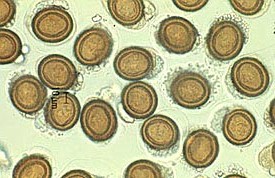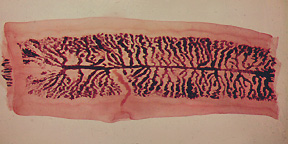Taenia saginata (continue)
-
To know the pathognomonic symptoms and signs.
- To explain why these symptoms and signs occur.
- To sort methods of diagnosing taeniasis saginata.
- To list drugs which can treat the infection.
- To list methods of control of taeniasis saginata.
a)
Presence of the large sized parasite in the
small intestine will interfere with the digestive and absorptive function of
the intestine leading to intestinal disturbances and obstruction.
b)
Parasite will consume much of the food of the
patient leading to loss of weight.
c)
Stray segments of the worm may lead to appendicitis or cholangitis.
d) Migrating
segments creeping out of the anus cause irritation, itching and worry of the
patient.
-
Most infection comes to light because the
patient notices the white motile segments in the faeces, under clothes or in
bed.
-
Detection
of eggs in faeces.

-
Recovery of eggs from perianal region using a
swab.
-
Searching for gravid segments in faeces, if not
found give a saline purge. Compress the segments between two slides and count
the main lateral branches.

- Praziquantel and Niclosamide which lead to
disintegration of segments of the parasite.
1.
Treatment of infected individuals (who are the
only source of infection to the intermediate host).
2.
Prevention of contamination of soil with human
faeces.
3.
Protection of intermediate host by preventing
them from grazing in contaminated areas.
4.
Proper inspection of slaughtered cattle.
Infected carcasses must be condemned.
5. Thorough cooking or deep freezing of meat to kill larvae.
A
patient, 20 years old, suffering from hunger pains and loss of weight. He
passed white segments about 2 cm long with and without defaecation which cause
irritation and itching in the perianal region. The patient is fond of eating
roasted meat.
What is your diagnosis and causative parasite?
What is the infective stage?
What are the complications of this parasitic infection?